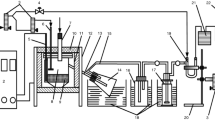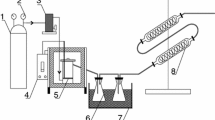Abstract
For obtaining high shale oil yield as well as treating shale char efficiently and in an environmentally friendly way in a new comprehensive utilization system of oil shale, a series of fundamental experiments have been conducted for exploring the effects of retorting factors on shale oil yield and shale char characteristics. Based on these previous studies, in this article, combustion experiments of shale chars obtained under various retorting conditions were performed with a Q5000IR thermogravimetric analyzer and a Leitz II-A heatable stage microscope and the effects of retorting factors were discussed on the combustion characteristics of shale char. Among four studied retorting parameters, retorting temperature and residence time exert very significant influence on the combustion characteristics of shale char. Either elevating the retorting temperature from 430 to 520 °C or lengthening the residence time at a low retorting temperature will largely decrease residual organic matters within shale char, resulting in decreasing mass loss in the low-temperature stage of combustion process of shale char, an elevation of ignition temperature and a shift of ignition mechanism from homogeneous to heterogeneous. One set of retorting condition was also recommended as a reference for designing the comprehensive utilization system of oil shale studied in this work: retort temperature of 460–490 °C, residence time of 20–40 min, particle size of <3 mm, and low heating rate of <10 °C/min.






Similar content being viewed by others
References
Qian JL, Wang JQ, Li SY. World’s oil shale available retorting technologies and the forecast of shale oil production. In: Proceedings of the eighteenth international offshore and polar engineering conference, 6–11 July, 2008, Vancouver, Canada, p. 19–20.
Trikkel A, Kuusik R, Maljukova N. Distribution of organic and inorganic ingredients in Estonian oil shale spent shale. Oil Shale. 2004;21:227–36.
Kuusik R, Martins A, Pihu T, Pesur A, Kaljuvee T, Prikk A, et al. Fluidized-bed combustion of oil shale retorting solid waste. Oil Shale. 2004;21:237–48.
Han XX, Jiang XM, Cui ZG. Study of the combustion mechanism of oil shale semicoke in a thermogravimetric analyzer. J Therm Anal Calorim. 2008;92:595–600.
Lyon RK, Hardy JE. Combustion of spent shale and other nitrogenous chars. Combust Flame. 1983;51:105–7.
Jiang XM, Han XX, Cui ZG. New technology for the comprehensive utilization of Chinese oil shale resources. Energy. 2007;32:772–7.
Jiang XM, Han XX, Cui ZG. Progress and recent utilization trends in combustion of Chinese oil shale. Prog Energy Combust Sci. 2007;33:552–75.
Han XX, Jiang XM, Cui ZG. Studies of the effect of retorting factors on the yield of shale oil for a new comprehensive utilization technology of oil shale. Appl Energy. 2009;86:2381–5.
Han XX, Jiang XM. Effects of retorting factors on combustion properties of shale char. 1. Pyrolysis characteristics. Energy Fuels. 2009;23:677–82.
Han XX, Jiang XM, Cui ZG, Liu JG, Yan JW. Effects of retorting factors on combustion properties of shale char. 3. Distribution of residual organic matters. J Hazard Mater. 2010;175:445–51.
Han XX, Jiang XM, Cui ZG, Liu JG, Yan JW. Effect of retorting parameters on pore structure of Dachengzi oil shale char. Submitted to Energy Fuels. 2010.
Kök MV, Iscan AG. Oil shale kinetics by differential methods. J Therm Anal Calorim. 2007;88:657–61.
Kök MV. Heating rate effect on the DSC kinetics of oil shales. J Therm Anal Calorim. 2007;90:817–21.
Yağmur S, Durusoy T. Kinetics of the pyrolysis and combustion of Goynuk oil shale. J Therm Anal Calorim. 2006;86:479–82.
Degirmenci L, Durusoy T. Effect of heating rate and particle size on the pyrolysis of Goynuk oil shale. Energy Sources. 2005;27:787–95.
Yağmur S, Durusoy T. Kinetics of combustion of oil shale with polystyrene. J Therm Anal Calorim. 2009;96:189–94.
Aboulkas A, El Harfi K, El Bouadili A, Nadifiyine M, Benchanaa M. Study on the pyrolysis of Moroccan oil shale with poly (ethylene terephthalate). J Therm Anal Calorim. 2009;96:883–90.
Kaljuvee T, Keelmann M, Trikkel A, Kuusik R. Thermoxidative decomposition of oil shales. J Therm Anal Calorim. 2010. doi:10.1007/s10973-010-1033-0.
Arenillas A, Rubiera F, Arias B, Pis JJ, Faundez JM, Gordon AL, et al. A TG/DTA study on the effect of coal blending on ignition behaviour. J Therm Anal Calorim. 2004;76:603–14.
Kök MV. Temperature-controlled combustion and kinetics of different rank coal samples. J Therm Anal Calorim. 2005;79:175–80.
Kök MV. Thermal analysis applications in fossil fuel science: literature survey. J Therm Anal Calorim. 2002;68:1061–77.
Krishnaswamy S, Bhat S, Gunn RD, Agarwal PK. Low-temperature oxidation of coal 1. A single-particle reaction-diffusion model. Fuel. 1996;75:333–43.
Kök MV, Pokol G, Keskin C, Madarasz J, Bagci S. Combustion characteristics of lignite and oil shale samples by thermal analysis techniques. J Therm Anal Calorim. 2004;76:247–54.
Vantelon JP, Breillat C, Gaboriaud F, Alaoui-Sosse A. Thermal degradation of Timahdit oil shales. Behaviour in inert and oxidizing environments. Fuel. 1990;69:211–5.
Wen CS, Kobylinski TP. Low-temperature oil shale conversion. Fuel. 1983;62:1269–73.
Tiikma L, Zaidentsal A, Tensorer M. Formation of thermobitumen from oil shale by low-temperature pyrolysis in an autoclave. Oil Shale. 2007;24:535–46.
Miknis FP, Turner TF, Berdan GL, Conn PJ. Formation of soluble products from thermal decomposition of Colorado and Kentucky oil shales. Energy Fuels. 1987;1:477–83.
Acknowledgements
This work was supported by the National Natural Science Foundation of China (Grant No. 50906051).
Author information
Authors and Affiliations
Corresponding author
Rights and permissions
About this article
Cite this article
Han, X.X., Jiang, X.M., Cui, Z.G. et al. Effects of retorting factors on combustion properties of shale char. J Therm Anal Calorim 104, 771–779 (2011). https://doi.org/10.1007/s10973-010-1179-9
Received:
Accepted:
Published:
Issue Date:
DOI: https://doi.org/10.1007/s10973-010-1179-9




